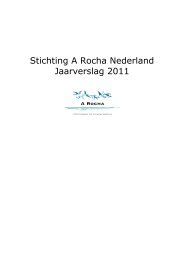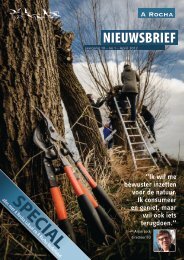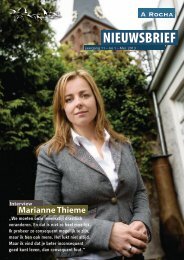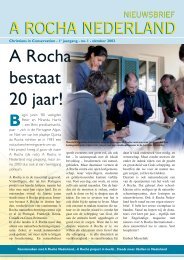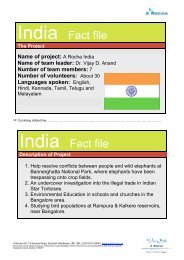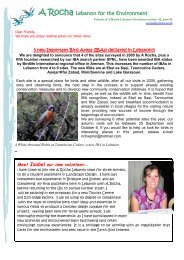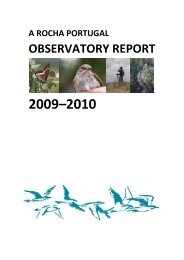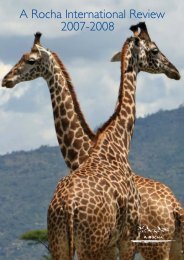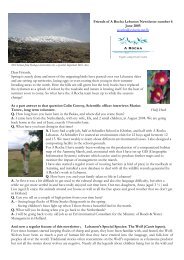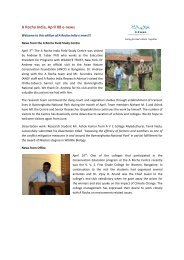A Rocha International Review 2010/2011
A Rocha International Review 2010/2011
A Rocha International Review 2010/2011
Create successful ePaper yourself
Turn your PDF publications into a flip-book with our unique Google optimized e-Paper software.
Community-based<br />
conservation<br />
A <strong>Rocha</strong> works with communities to restore and<br />
protect threatened habitats and endangered wildlife. As<br />
conservationists, we know that the actions of any<br />
community, for better or worse, affect their local habitats,<br />
and without their engagement any improvement cannot<br />
be sustained. As Christians, we are committed to<br />
community conservation because we believe that God<br />
made human beings an integral part of the creation,<br />
dependent on its health and diversity, with special<br />
responsibility to care for it.We believe that although people<br />
often cause the problem, they can also be the solution.<br />
Case study: Protecting<br />
one of Africa’s most<br />
important forests<br />
The A <strong>Rocha</strong> Kenya field study centre, Mwamba, is on the<br />
coast and close to the Arabuko-Sokoke Forest, an Important<br />
Bird Area which is vital for six Globally Threatened Species.<br />
Having a permanent base here has enabled the team to build<br />
long-term relationships with local communities, and it became<br />
clear that a major reason for illegal logging in the forest was due<br />
to the need for local families to find cash for secondary school fees.<br />
A <strong>Rocha</strong> Kenya initiated the ASSETS eco-bursary scheme as a<br />
vital component of their community conservation programme.<br />
It provides grants of up to 90% of a youngster’s school fees.<br />
In return, parents agree not to log in the forest.<br />
In <strong>2010</strong>, 205 students received bursaries and 27 of these<br />
students were new, from eight primary schools.<br />
In April, with many of the newer students and parents in the<br />
audience, some of the older students debated the question,<br />
‘Should Arabuko-Sokoke Forest be cleared for farmland and<br />
settlement?’. Parents and youngsters participate in a range of<br />
educational and practical conservation activities which are<br />
changing attitudes and behaviour. In August, two summer clubs<br />
were run at Mwamba, each for 20 ASSETS students over three<br />
days. They were shown local wildlife, such as turtles, and<br />
snorkelled on the nearby reefs, seeing multitudes of brightly<br />
coloured fish and other marine life for the first time, which<br />
they described as a fantastic experience. They learned about<br />
local conservation issues and gained additional teaching about<br />
career opportunities and HIV & AIDS prevention.<br />
The major tree-planting event was at a secondary school in<br />
Mijomboni on the northern edge of the forest. ASSETS<br />
beneficiary parents, local church members and primary<br />
school children planted the highly valuable native hardwood<br />
Afzelia quanzensis. In addition,<br />
many familiesarelearninghowto<br />
growtrees for domestic needs on<br />
their own plots: fast-growing<br />
exotic species provide poles to<br />
rebuild their homes or sell for<br />
cash, relieving pressure on the<br />
forest, and the mangroves<br />
which protect the shore.<br />
An ASSETS internship<br />
programme was initiated at<br />
Mwamba, enabling two schoolleavers<br />
at a time to gain work<br />
experience: computer lessons,<br />
kitchen work, housekeeping,<br />
welcoming guests, working with<br />
tourists at the Gede Ruins<br />
Tree Platform and taking part<br />
in bird ringing and wildlife<br />
monitoring.<br />
The nearby Turtle Bay Beach<br />
Club also offers internships<br />
to ASSETS graduates. Whilst<br />
training in their Controls<br />
Department for eight months,<br />
Fauzia Mwanyule lived at<br />
Mwamba and secured<br />
sponsorship for her university<br />
education from some generous<br />
Mwamba guests.<br />
The income for ASSETS staff<br />
and fees comes from grants,<br />
individual donors and incomegenerating<br />
projects initiated by<br />
A <strong>Rocha</strong>, such as the provision<br />
of tree platforms and hides<br />
for tourists.<br />
The Narina Trogon Apaloderma narina<br />
hunts insects from the middle-level<br />
canopy of the Arabuko-Sokoke Forest<br />
and relies on natural tree cavities for<br />
nest sites. (Steffen Foerster)<br />
Arabuko-Sokoke Forest is now the<br />
largest stretch of coastal forest in<br />
Eastern Africa. (Dan Tay)<br />
Fauzia Mwanyule, an ASSETS graduate<br />
now studying at Kenyatta University,<br />
Nairobi.<br />
3




